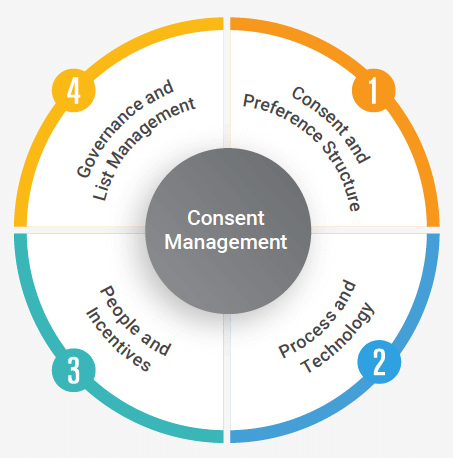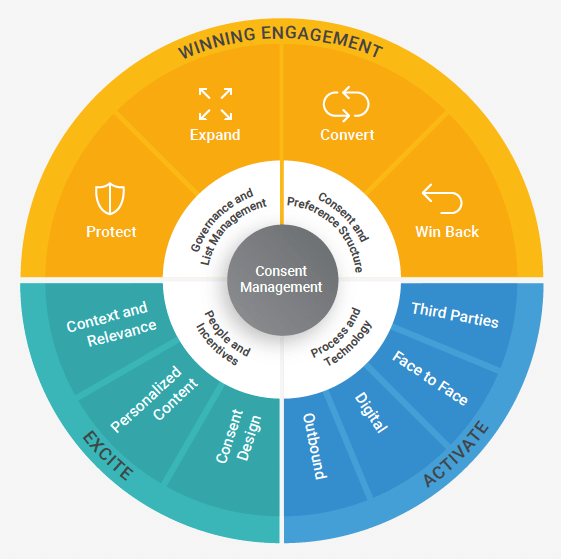Article
4 Key Ingredients in HCP Communication and Consent
THOUGHT STARTER SERIES
Today, many healthcare professionals (HCPs) expect to engage with pharma companies through various digital channels, such as apps and virtual chat tools, and the majority (87%) say they want to participate in virtual or a mix of virtual and in-person meetings after the pandemic ends.* Engaging through digital channels is now the expectation for HCPs and commercial teams, but it requires consent in many countries.
Balancing the needs of HCPs with your organization’s access to them is crucial. It’s important to place customers’ preferences in the center of your engagement with them. Customers want to feel empowered to opt-in or opt-out of communications easily, and pharma companies want to send HCPs relevant and personalized content. The goal is to strike the right balance. Here’s what you need to know about consent and why it’s an essential part of your omnichannel communication strategy.
Defining consent
Simply put, consent is a legally binding agreement between two parties, such as pharma companies and HCPs. Although regulations vary across different markets, some standard legal consent requirements include:
- Delivering digital marketing,
- Maintaining and processing customer personal data within your organization, and
- Tracking customer engagement with your digital content.

Managing consent complexity

Managing consent becomes more complicated as you develop your omnichannel strategies and increase the number of channels where you engage with HCPs. Regulations vary across markets, such as GDPR in the European Union and LGPD in Brazil, and globally are likely to change over time and may even become more stringent. Meanwhile, different functions within pharma companies have other priorities when engaging with HCP customers, increasing complexity further.
Therefore, standardization and alignment across functions are critical for establishing a solid foundation in consent. It’s essential to have the right technology in place that will ensure customer-facing teams understand HCPs’ most up-to-date consent preferences. Here are four key enablers of a robust consent management framework:
1. Consent and preference structure
It’s essential to agree on your consent and preference structure and determine which elements of your omnichannel strategy require consent. For example, consents might include storing and processing data, sending promotional or non-promotional digital communications, and tracking your customers’ data so that you can personalize your communications. Additionally, you may want to offer your customers the ability to control their preferences. For example, you could determine which channels you plan to use with your customers and the preferences you want to offer them. Finally, you could provide options for your customers Managing consent complexity to reduce or manage the frequency of communications with you. Whatever you choose to include in your consent and preferences, you must ensure your organization can meaningfully follow them.
2. Process and technology
It’s important to have a clear view of the processes you have for customers to opt-in, manage their preferences, and opt-out if they no longer want to receive communications. Veeva CRM has a consent capture module that can help with rep-customer engagement and collection and management of consent.
3. People and incentives
The core groups involved in capturing and maintaining your consents, particularly across sales and marketing, should clearly understand what consents and preferences are, why they’re important, and they should feel incentivized to gather these consents.
4. Governance and list management
Once you define your consent framework, you need to work with the right people across your organization, whether at a global, regional, or local level, to determine the structure, ensure that teams adhere to it, and make changes and updates as needed. You should clarify any local legal requirements with the local and central legal teams to ensure you comply with the consent structure.
Building your consent acquisition strategy
Once you have a clear consent management foundation, you can build your consent acquisition strategy on top of it. Starting with the HCPs that you have a good relationship with, you want to protect that consent and ensure that you provide them with the content and the engagement they want so they will want to remain engaged with you.
From there, you can expand beyond those existing customers to broader customers and consent types. There are opportunities to provide consent and convert customers with every customer touchpoint.
It’s also critically important to track where you may be losing consent so you can improve your engagement and win back consent. By providing exciting, relevant, personalized content that appeals to your customers, you’re making it easy for them to give you their consent.
As you engage with your customers, there are many opportunities to capture consent. You should make the most of face-to-face and digital touchpoints such as webinar sign-ups, HCP portals, consent capture sites, third party, outbound, and any other touchpoints that work for you and your customers.
As you define and implement your consent framework, you need to make four decisions:
1. WHAT are the activities that require consent? Be clear about your omnichannel strategy, what consents you need, the preferences you want to offer, and how you will allow your customers to manage them.
2. WHO needs to be engaged when you define this approach and roll it out globally, regionally, and on a local level? Make sure you consider everyone who’s going to be engaged, including sales, marketing, medical, legal and regulatory, and regional and local partners. Once you have agreed on your approach as an organization,
3. HOW will you roll out the framework and ensure your teams’ compliance? Ensuring compliance is essential and challenging as rules, regulations, and business needs change.
4. WHAT help do sales and marketing people need, as they are at the forefront of collecting and managing consents and preferences?
After you’ve checked off these essential to-do’s, you’ll be ready to move forward with a communication strategy built on consent. It comes back to striking the right balance in developing communications that work for all parties—HCPs and commercial teams alike.

Key Takeaways
- Make consents and preferences meaningful for your customers: Ensure the consents and the preferences you gather are aligned with the omnichannel strategy you have planned and that the engagement works for your customers.
- Put in place strong governance: Establish your consent strategy underpinned by regulatory and legal requirements. You must have strong governance to help you define your consent structure and ensure you can implement it and update it well.
- Focus on HCP experience: Enable an excellent experience for your HCPs. Understand their journey and make it simple for them to feel in control and empowered.
- Keep it simple: Focus on providing personalized, relevant content that will engage your customers.
Annie Geraghty
Senior Business Consultant
annie.geraghty@veeva.com
Zoe Dixon
Business Consultant
zoe.dixon@veeva.com